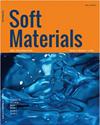成纤维细胞在二维丝-纤维蛋白水凝胶基质上的形态和细胞牵引
IF 1.4
4区 材料科学
Q4 MATERIALS SCIENCE, MULTIDISCIPLINARY
引用次数: 2
摘要
摘要开发具有临床应用价值的丝素蛋白生物植入物,需要对细胞和基质之间产生的细胞牵引力进行表征。然而,关于细胞在SF基质上的生物力学反应的研究是有限的。在本研究中,我们制备了不同顺应性的SF水凝胶(SF30和SF50)和不同表面配体(用聚赖氨酸(PLL)或Arg-Gly-Asp(RGD)肽衍生)。随后,在这些基质上生长NIH-3T3成纤维细胞,并检测其形态变化。观察到SF硬度从0.7kPa增加到3.1kPa降低了细胞核与细胞质的面积比,并增加了沿细胞主轴的不对称性。此外,虽然RGD对SF的功能化诱导了细胞面积和圆形度的增加,但PLL的功能化没有引起任何变化。接下来,使用牵引力显微镜(TFM),我们量化了在SF水凝胶上培养的NIH-3T3细胞的2D细胞牵引。与SF30相比,接种在SF50水凝胶上的细胞表现出显著高的牵引应力;功能化的变化没有显示出显著的变化。此外,发现突起牵引应力大于核牵引应力。总之,我们的结果表明,SF水凝胶的表面硬度,而不是表面配体的性质,调节细胞形态和细胞牵引应力。本文章由计算机程序翻译,如有差异,请以英文原文为准。
Morphology and cellular-traction of fibroblasts on 2D silk-fibroin hydrogel substrates
ABSTRACT Development of clinically amenable bio-implants with silk-fibroin (SF) necessitates characterization of cellular-traction generated between cells and the substrate. However, studies on the biomechanical response of cells on SF substrates are limited. In this study, we prepared SF hydrogels of varying compliance (SF30 and SF50) and varying surface-ligands (derivatized with poly-L-lysine (PLL) or Arg-Gly-Asp (RGD) peptide). Subsequently, NIH-3T3 fibroblast cells were grown on these substrates, and the morphological changes was examined. It was observed that the increase in SF stiffness from 0.7 kPa to 3.1 kPa decreased nucleus-to-cytoplasm area-ratio and increased asymmetricity along the major-axis of cells. Moreover, while functionalization of SF with RGD induced increase in cell-area and circularity, functionalization with PLL did not cause any change. Next, using traction-force-microscopy (TFM), we quantified 2D cell-traction for NIH-3T3 cells cultured on SF hydrogels. Cells plated on SF50 hydrogel exhibited significantly high traction stress as compared to SF30; change of functionalization did not show significant change. Also, protrusion traction stress was found to be greater than nuclear traction stress. Put together, our results suggest that surface-stiffness of SF-hydrogel, rather than nature of surface-ligand, regulates both cellular morphology and cellular traction stresses.
求助全文
通过发布文献求助,成功后即可免费获取论文全文。
去求助
来源期刊

Soft Materials
工程技术-材料科学:综合
CiteScore
2.90
自引率
0.00%
发文量
21
审稿时长
2.2 months
期刊介绍:
Providing a common forum for all soft matter scientists, Soft Materials covers theory, simulation, and experimental research in this rapidly expanding and interdisciplinary field. As soft materials are often at the heart of modern technologies, soft matter science has implications and applications in many areas ranging from biology to engineering.
Unlike many journals which focus primarily on individual classes of materials or particular applications, Soft Materials draw on all physical, chemical, materials science, and biological aspects of soft matter. Featured topics include polymers, biomacromolecules, colloids, membranes, Langmuir-Blodgett films, liquid crystals, granular matter, soft interfaces, complex fluids, surfactants, gels, nanomaterials, self-organization, supramolecular science, molecular recognition, soft glasses, amphiphiles, foams, and active matter.
Truly international in scope, Soft Materials contains original research, invited reviews, in-depth technical tutorials, and book reviews.
 求助内容:
求助内容: 应助结果提醒方式:
应助结果提醒方式:


